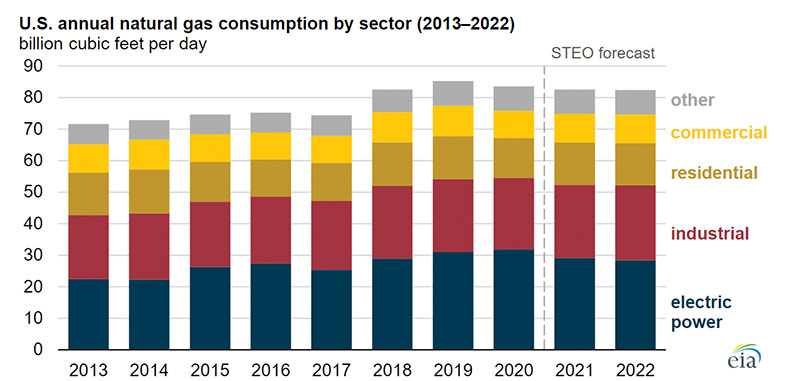November 2021, Vol. 248, No. 11
Features
US Natural Gas Consumption to Fall Through 2022, Data Shows
Special to P&GJ
The EIA Short-Term Energy Outlook (STEO) shows U.S. consumption of natural gas is expected to decline from 2020 levels in all end-use sectors except in the industrial sector and among non-specific users, such as lease and plant fuel, pipeline and distribution use, and vehicle use.
The largest decline will occur in the electric power sector, where consumption is expected to average 82.5 Bcf/d (2.34 Bcm/d) in 2021, down 700 MMcf/d (19.8 MMcm/d) from 2020. Usage levels in 2022 should increase slightly from 2021 due to industrial sector offsets in declining consumption in the electric power sector.
In the United States, natural gas prices influence natural gas consumption in the electric power sector. When natural gas prices are high, generators typically switch from natural gas to lower-cost coal as the source for power generation.
During the first half of 2021, higher prices at Henry Hub, the U.S. natural gas benchmark, resulted in less natural gas consumption in the electric power sector than during the first half of 2020. The Henry Hub price is expected to average $3.63 per million British thermal units (MMBtu) in 2021, or $1.60/MMBtu more than the 2020 average.
That being the case, the EIA expects 2.7 Bcf/d (76 MMcm/d), or 8.3%, less consumption of natural gas in the U.S. electric power sector in 2021. Natural gas consumption in the U.S. industrial sector is projected to increase in 2022 to 23.8 Bcf/d (674 MMcm/d), from an average of 23.2 Bcf/d (657 MMcm/d) in 2021.
Natural gas consumed by the industrial sector is dependent on the level of industrial activity, which EIA measures in the STEO using a natural gas-weighted industrial consumption index.
The index reflects the growth of manufacturing subsectors and their relative importance to U.S. natural gas consumption. The index is expected to increase 5.8% in 2021 from 2020 levels and another 5.8% in 2022 from 2021 levels, reflecting continuing post-pandemic economic growth.






Comments